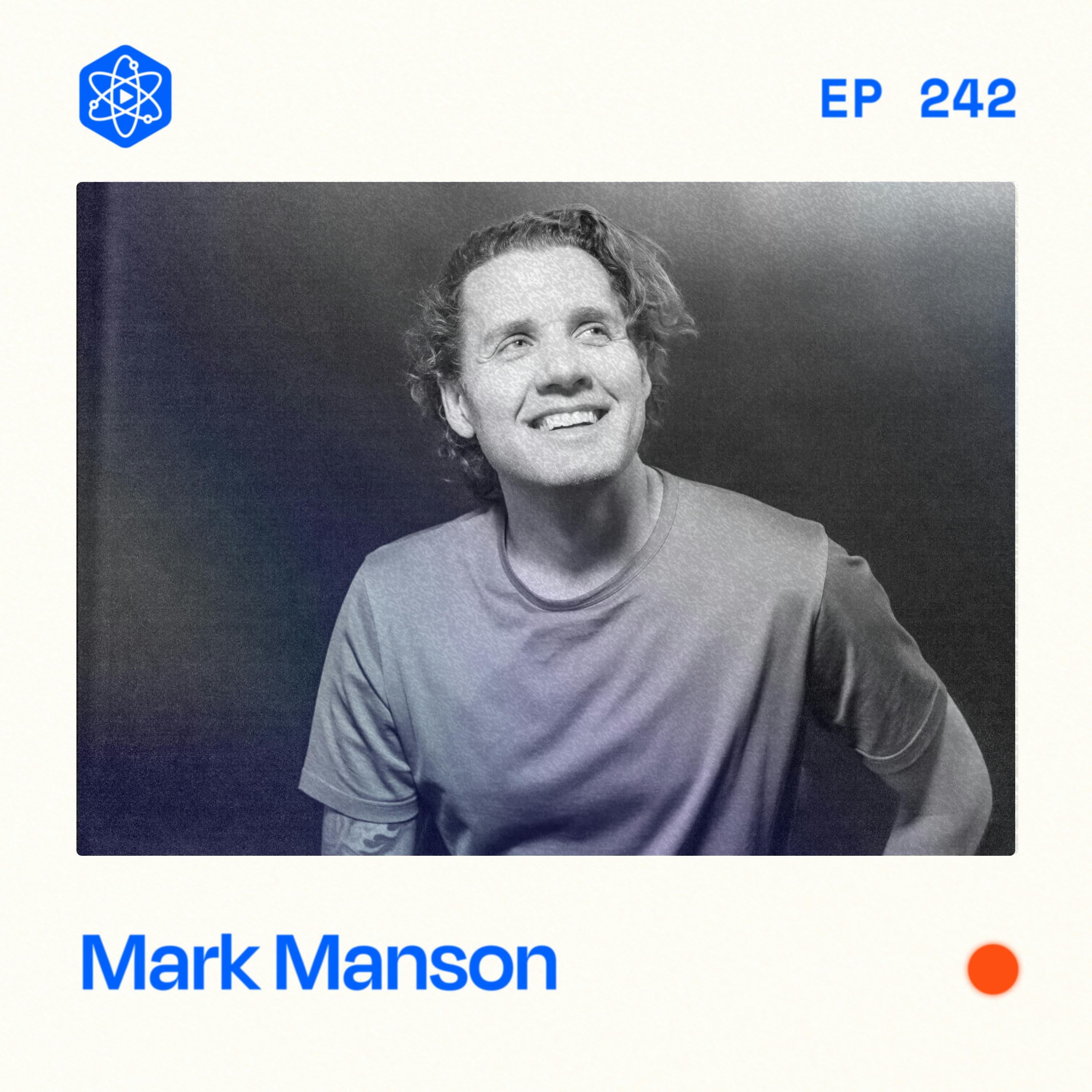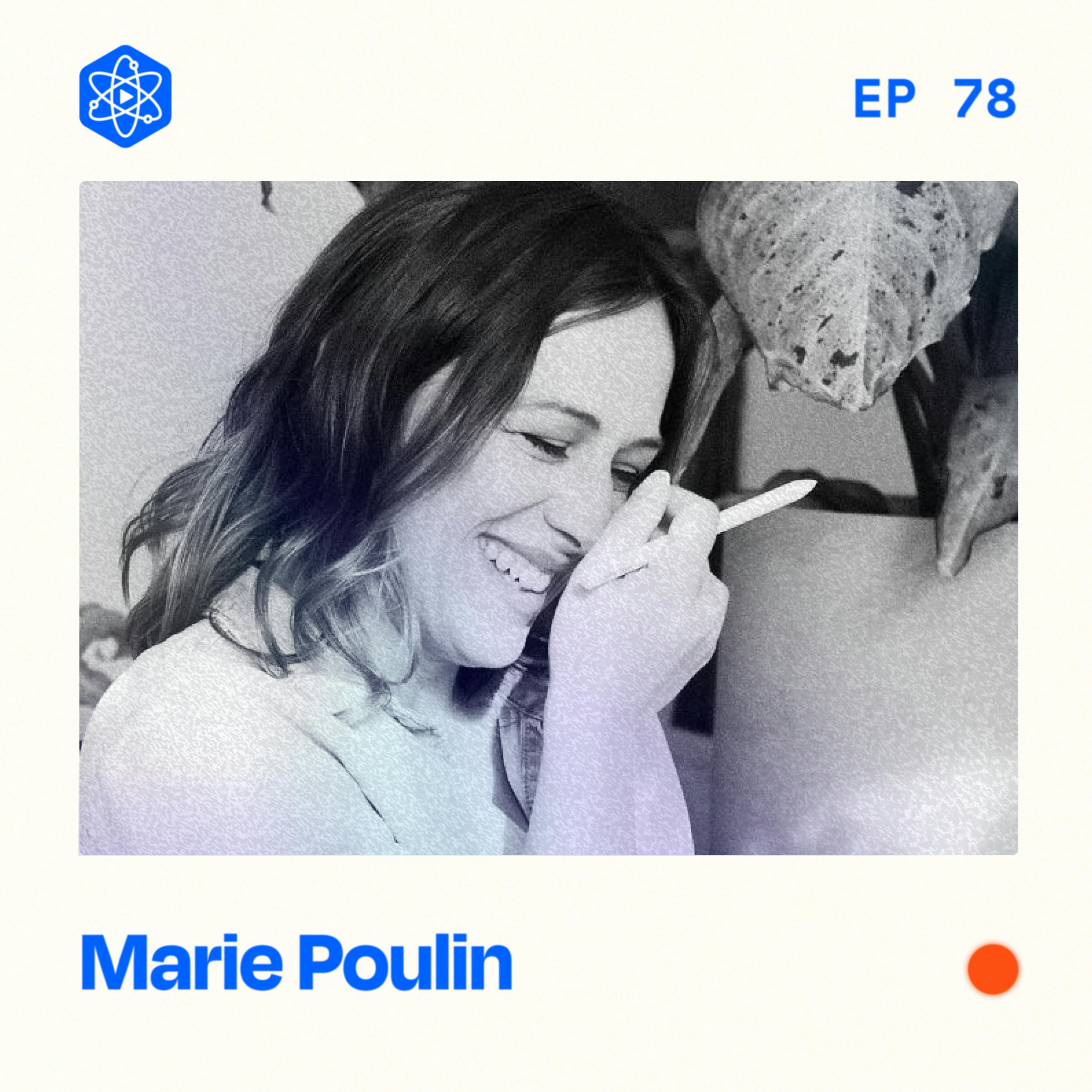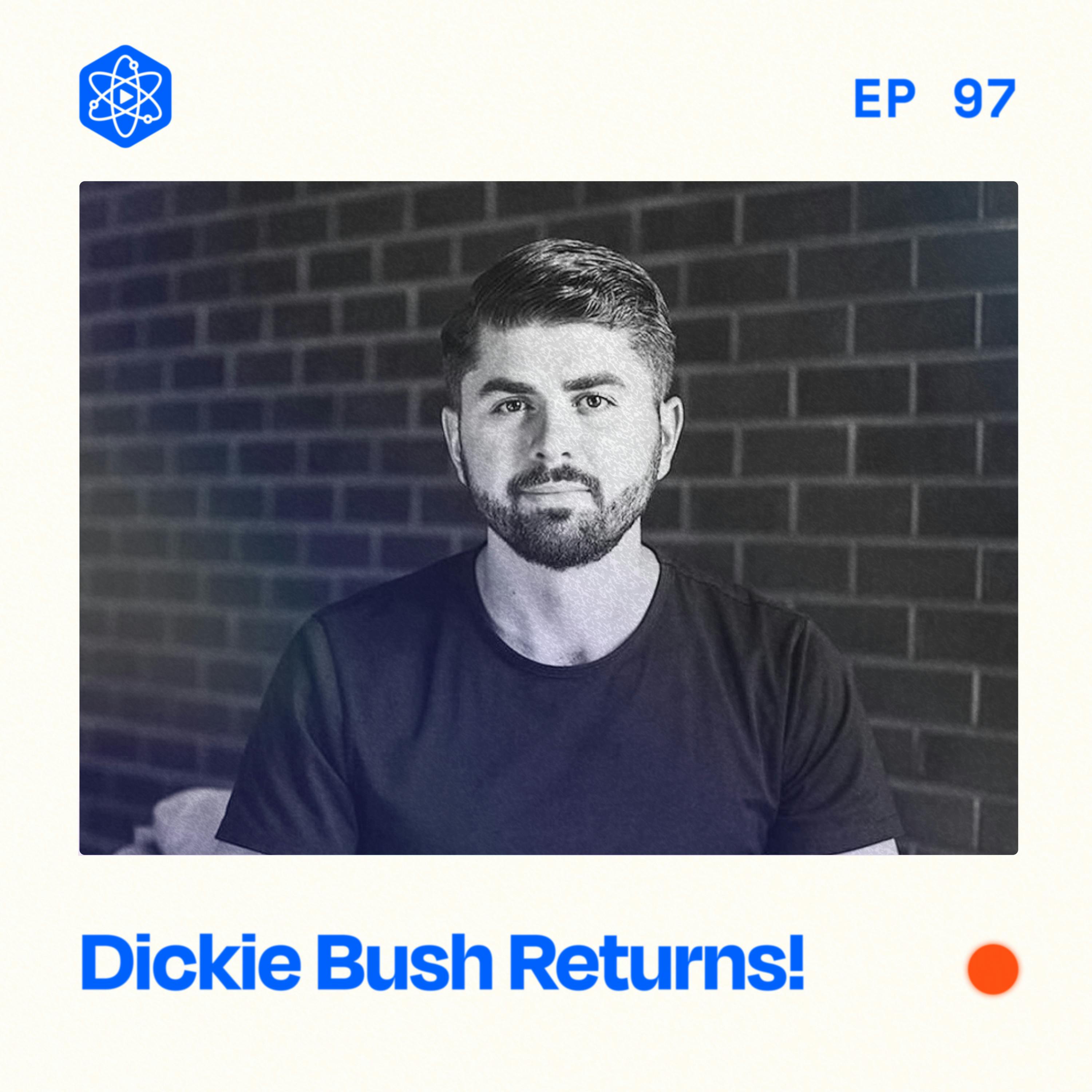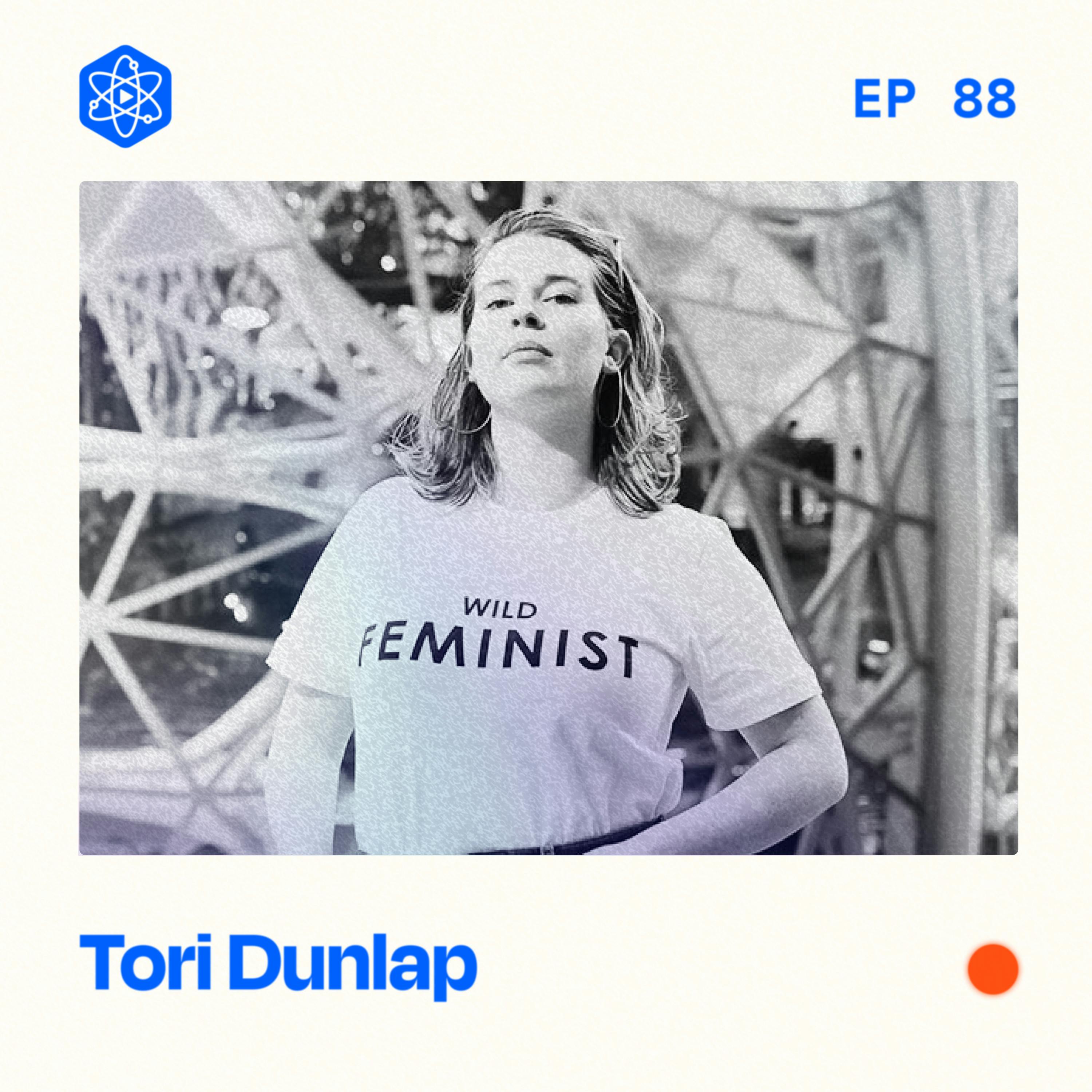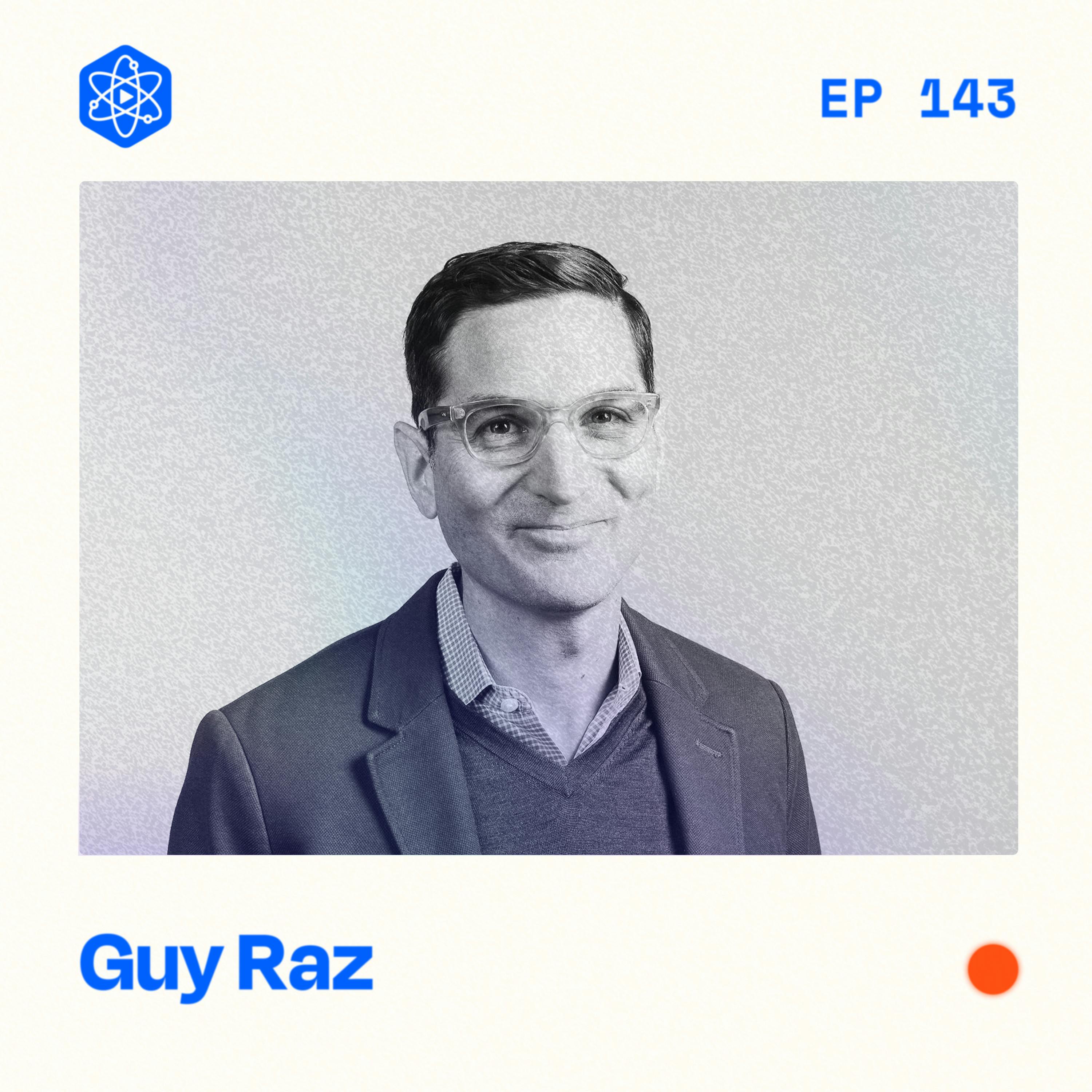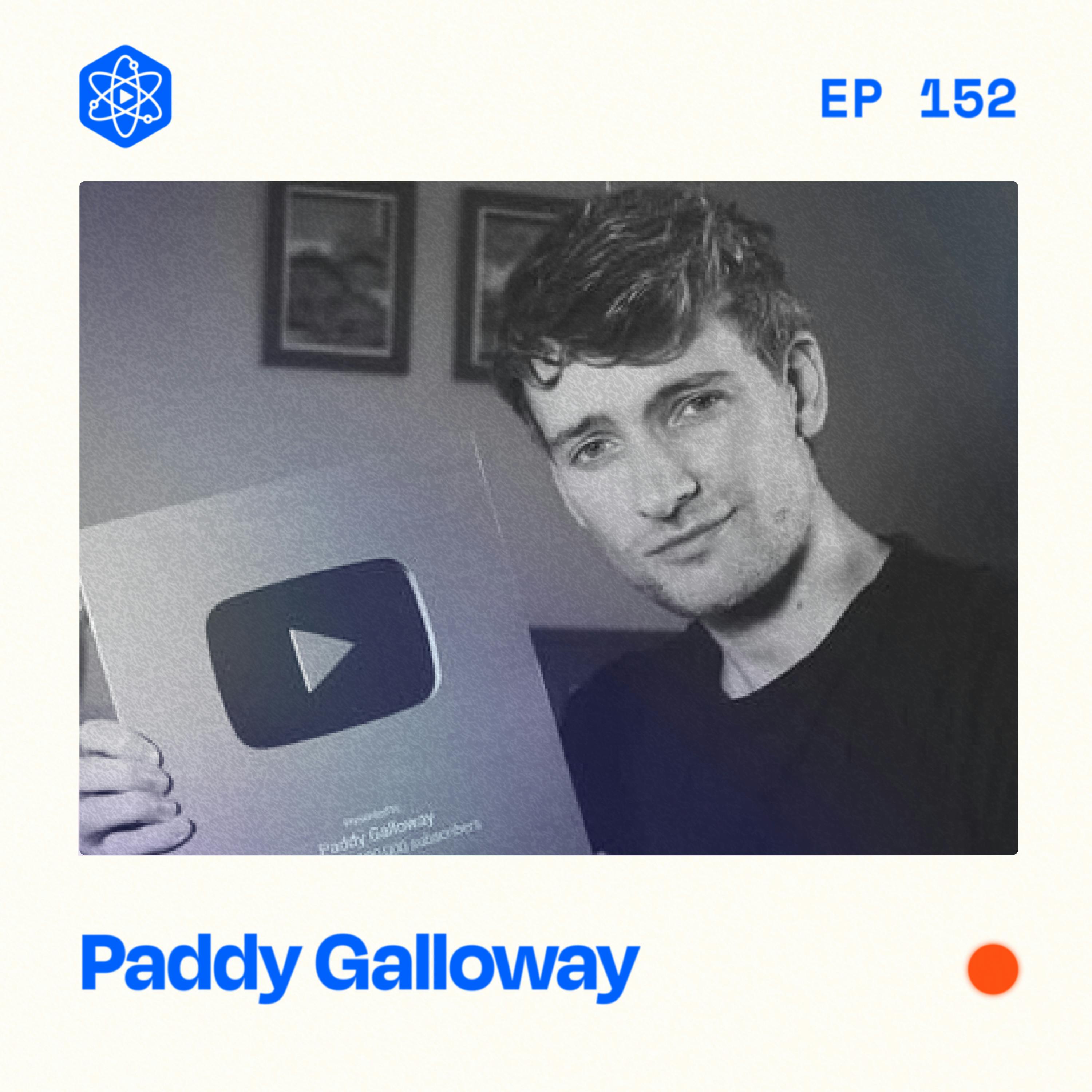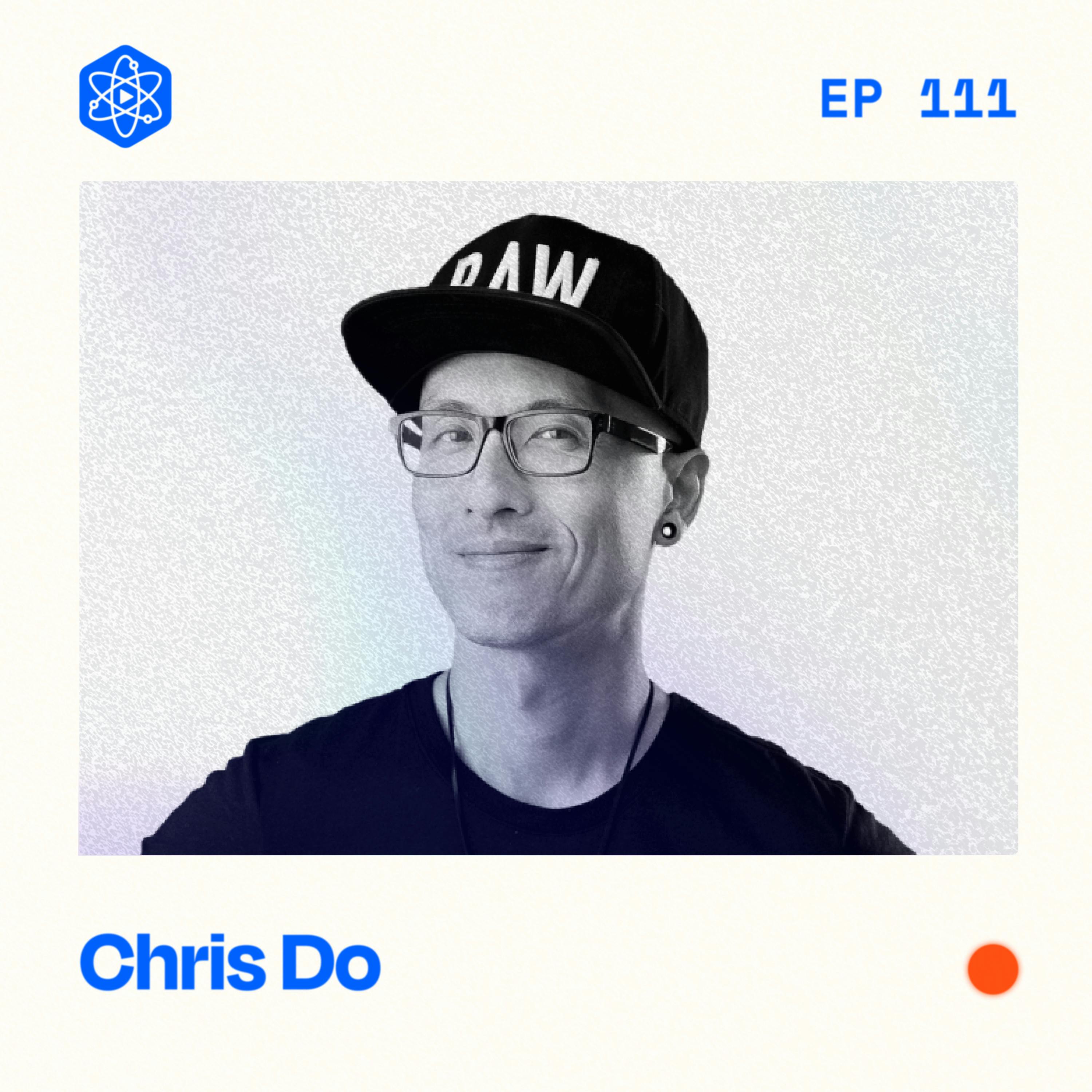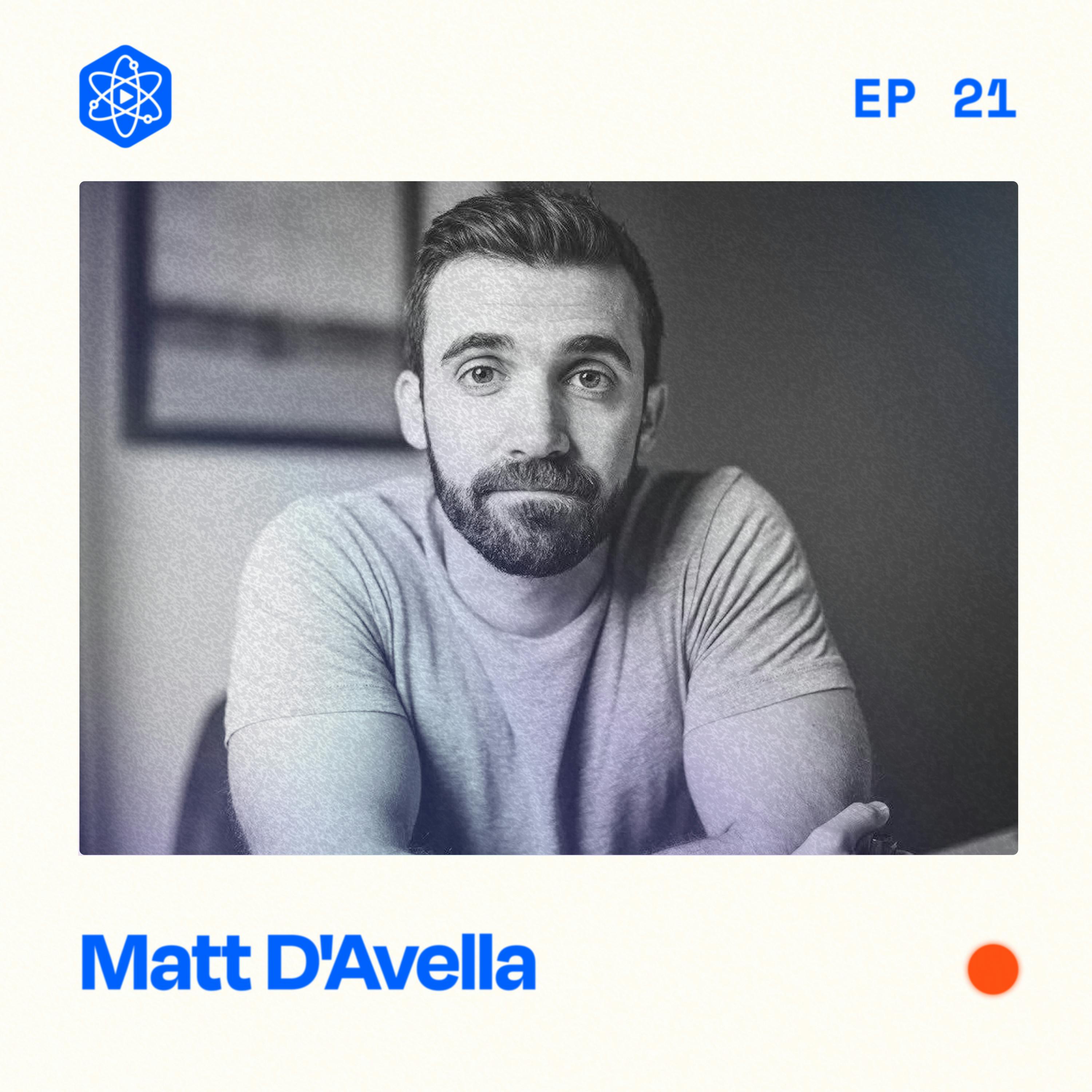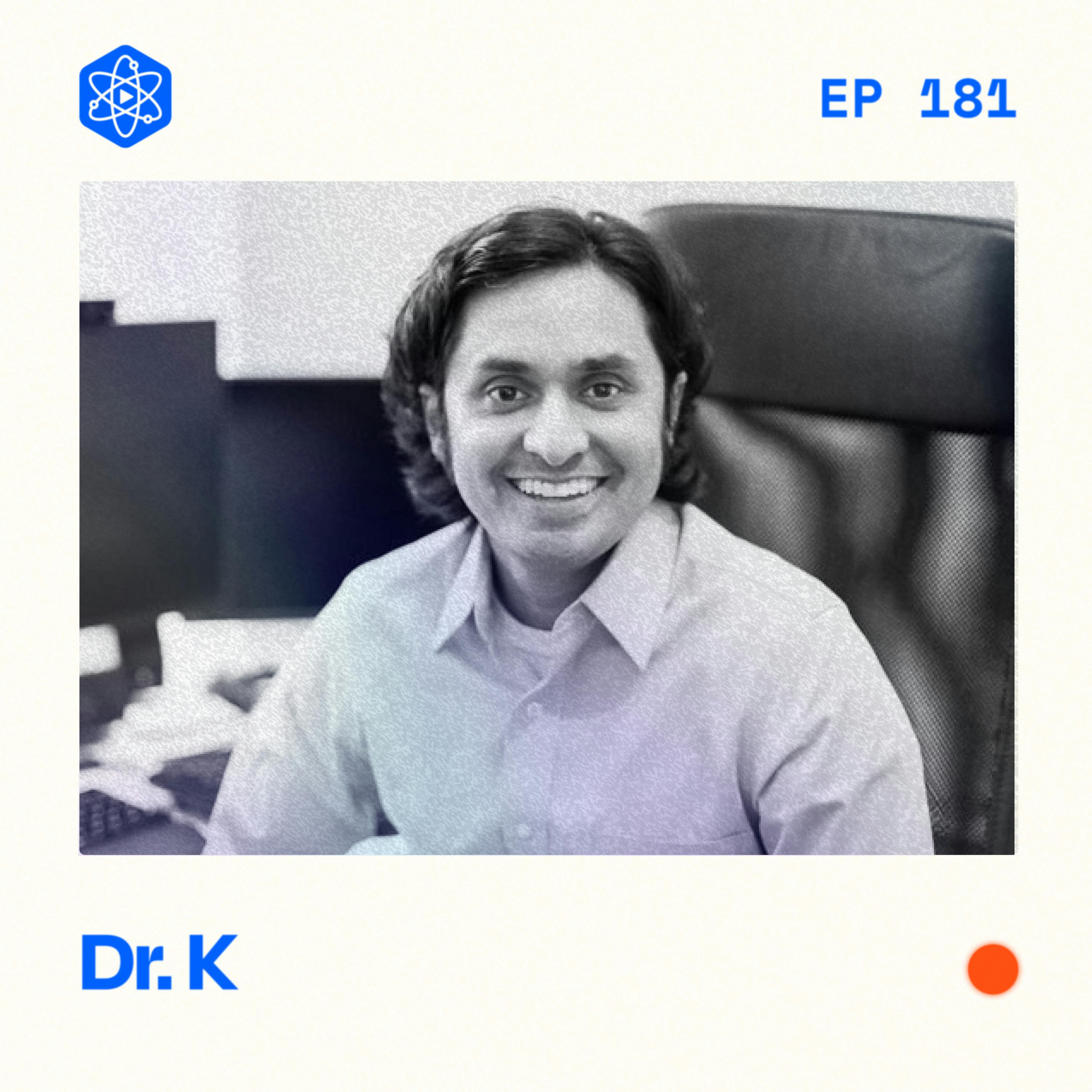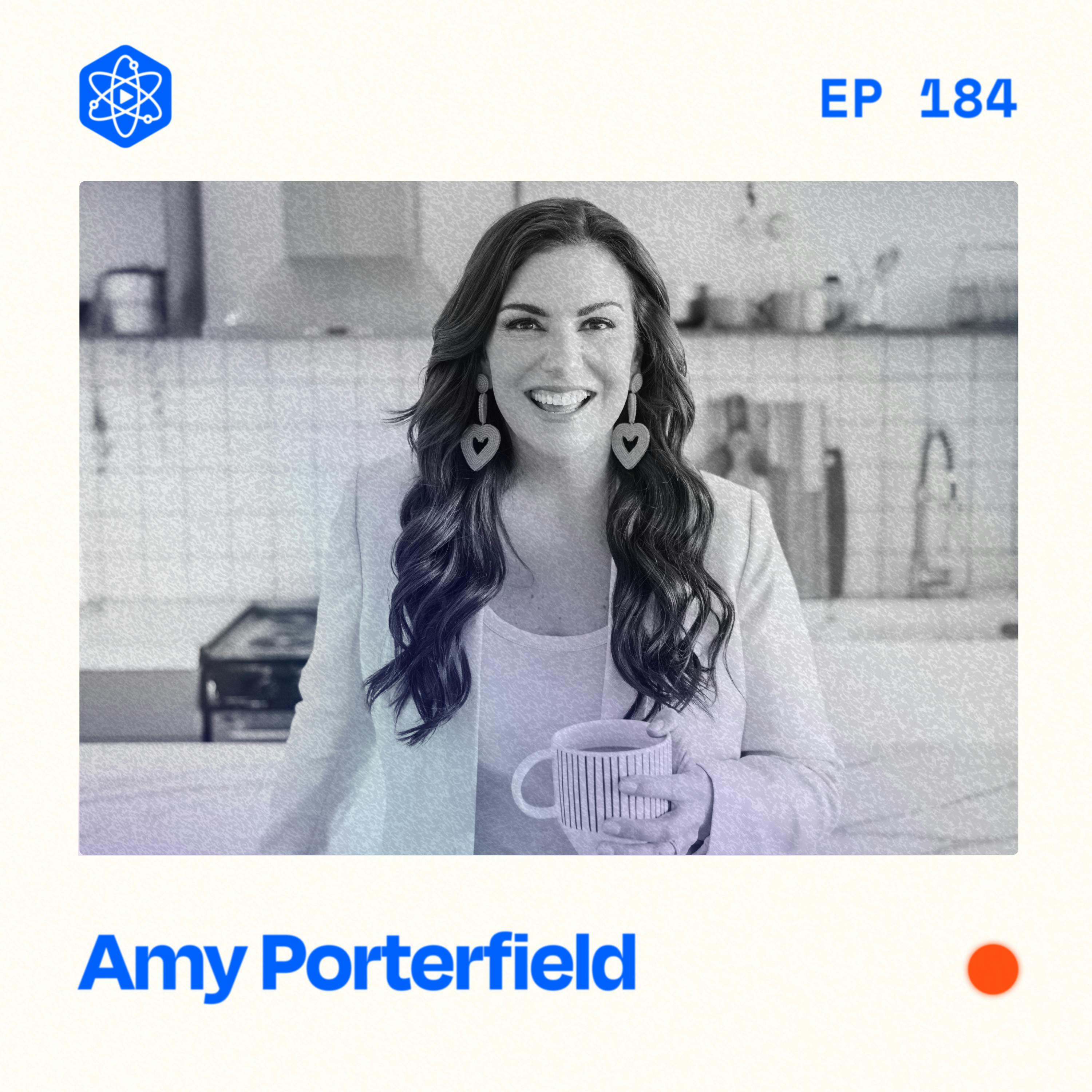Mark Manson is the author of the Subtle Art of Not Giving a F*ck and a YouTuber with more than 2 million subscribers.
Mark Manson is an entrepreneur. He is an author who wrote the best-selling book, The Subtle Art of Not Giving a F*ck. Mark is also a YouTuber.
However, his entrepreneurial first approach is how Mark has been able to speed run YouTube success, gaining 2,000,000 subscribers in just two years.
In this episode, we break down Mark's whole approach to YouTube, from content strategy to how he's setting up his channel for long-term success.
Full transcript and show notes
Mark's Website / Twitter / Instagram / YouTube / LinkedIn / TikTok
***
TIMESTAMPS
(00:00) YouTubers and Business
(01:13) Why Do YouTubers Suck at Business?
(10:14) Make Brainstorming Ideas Easy with 1of10
(11:50) How to Turn Your Channel into a Business
(15:55) When to Make the Transition
(24:43) When Maximizing Views is Bad
(27:31) The Case For Not Taking Brand Deals
(35:33) 1st Step to Take
(37:48) Futureproofing Your Channel
***
RECOMMENDED NEXT EPISODE
→ #179: Justin Moore – A step-by-step strategy to get anyone sponsored, regardless of audience size
***
ASK CREATOR SCIENCE
***
WHEN YOU'RE READY
🚀 Get CreatorHQ (creator operating system)
🧪 Join The Lab (private membership community)
***
CONNECT
***
SPONSORS
💼 View all sponsors and offers
***
SAY THANKS
Mark Manson [00:00:00]:
Most YouTuber businesses are incredibly unstable. If these channels are getting this many views and they clearly have no idea what they're doing on on the business side, there's a ton of opportunity here.
Jay Clouse [00:00:11]:
Meet Mark Manson. Mark is an author who wrote the best selling book, The Subtle Art of Not Giving a Wait. No. Mark is a YouTuber who hold on.
Mark Manson [00:00:23]:
I guess I identify as like a creator or an entrepreneur first. This entrepreneur first approach
Jay Clouse [00:00:28]:
is how Mark has been able to speed run YouTube success, gaining 2,000,000 subscribers in just two years. But beyond subscriber growth, here's why that approach is really important.
Mark Manson [00:00:39]:
The monetization on YouTube is is actually not great.
Jay Clouse [00:00:43]:
In this episode, we break down Mark's whole approach to YouTube from content strategy.
Mark Manson [00:00:47]:
There's growth oriented content and there's engagement oriented content. It's very hard to optimize for both of optimize for both of those things in the same piece of content.
Jay Clouse [00:00:55]:
To how he's setting up his channel for long term success.
Mark Manson [00:00:58]:
Most YouTube power users are probably teenagers or early twenties. What are they gonna be interested in seeing, say, five years from now? How can I be already excellent at that by the time they get there?
Jay Clouse [00:01:11]:
And now, let's talk with Mark Manson. What have you seen in terms of how entrepreneurial most YouTubers seem to be?
Mark Manson [00:01:23]:
I'm gonna be honest. I was a little shocked. I mean, granted, the the average YouTuber is quite young, but I was shocked at the lack of business sense and expertise. I noticed this too when I started hiring. You know, I hired most of the people on my team worked for other large YouTube channels, and the things that they would tell me about how their previous YouTube channels function was absolutely shocking to me. It it it actually made me more bullish on the space because I'm like, okay. If these channels are getting this many views and building audiences this big, and they clearly have no idea what they're doing on on the business side, there's a ton of opportunity here. Like, we are still very, very early innings.
Mark Manson [00:02:10]:
And I I guess I'll be a little bit specific here. When I say the business side, what I mean is, like, nuts and bolts stuff. So hiring, managing, clear communication, setting incentives properly, monetization, like, optimizing funnels. Right? So if somebody comes in through my YouTube channel and they subscribe and they watch a bunch of videos, obviously, the next thing I wanna do is get them onto my newsletter. And then once they're on the newsletter, I wanna, like, get them into a product or buying a book or signing up for a course. And it shocked me how many YouTubers not only, like, did not have those processes figured out, but didn't even know that that's what you should be doing.
Jay Clouse [00:02:51]:
Just nothing on the back end of views. Like, views, and that's it.
Mark Manson [00:02:55]:
Yeah. It's like maybe a brand sponsor. But even then, they're like, I don't know how to negotiate a price. I kinda just take whatever price they get. Like, I'm sitting there. I'm like, dude, you get, like, 2,000,000 views a video. Like, what are you talking about? You should be getting paid, like, three times as much as you're getting paid. It was shocking.
Mark Manson [00:03:12]:
I met, I went to a dinner here in LA, and I met a guy, wonderful guy, super nice. But, yeah, probably early twenties, YouTube channel, over 10,000,000 subscribers. And, one of the first questions he asked me was about taxes. And I was like, what do you mean? And he's like, what do you do for taxes? I'm like, I have a fucking CPA. Sorry. Can I curse?
Jay Clouse [00:03:37]:
Of course.
Mark Manson [00:03:38]:
I'm getting I'm getting worked up over here. Of course.
Jay Clouse [00:03:40]:
Of course.
Mark Manson [00:03:41]:
I just I kinda looked at it. I'm like, how much money are you making? Oh my god. So I actually think, and this is why I'm, like, I'm I'm really thrilled with, like, you know, what you're doing and what Nathan's doing, what Colin and Sameer are doing. Like, I think this is so important because I think this space the the audience of this space has grown so quickly, and the and the the creators growing these audiences are so young, and they've never had a real job. A lot of them never went to college. We need to get the business side caught up. Right? Like, all all this stuff all this stuff that happened with mister Beast, this year, it's funny because I've actually hired people who used to work for him, and I heard the stories from them. And it it I never I posted a little bit publicly, but I I remember thinking to myself, I'm like, man, this guy, he's gonna have something really bad's gonna happen.
Mark Manson [00:04:35]:
Like, something on set or there's gonna be a big lawsuit or something, you know, and all this stuff that has come out. And it's not surprising. It's like you've got this 20 year old guy who has never had a job in his life, and he's making millions of dollars, and he's hanging out like, his employees or his high school friends, like, of course of course, it's gonna be a rat's nest of a business, for four or five years until he gets it straightened out. So I I think there's for those the the people listening who are, you know, early early in their creator career or even if you're, like, well along, the business side of this is so important. Like, you have to take it seriously as, like, treat it as a start up, treat it as a small a small business. And if you don't enjoy that side of it, you really need to go find somebody who you can either hire or who can advise you to do these things properly because you can absolutely shoot yourself in the foot.
Jay Clouse [00:05:36]:
Yeah. I this is true not just of, like, the face on screen, but, like, the teams too. We we've gone through some thumbnail artists. Our first thumbnail artist that we had on the channel, super talented, couldn't get them to respond to an email or a message to save our life. And it wasn't that they didn't deliver, but, like, we had no reason to believe that they would. You know? Like, we would just get the files in our inbox hopefully before the deadline that we asked for them, but no communication up to that point. And it was so frustrating. Like, really talented young people who just don't have communication.
Jay Clouse [00:06:12]:
And it's really hard to work it's really hard to do a professional endeavor when you're not working with professionals.
Mark Manson [00:06:18]:
A %. I I actually you know, so we I have a team of about 15 people of which about half are on the video production, side of things. And it's funny because I find it so I I find it twice as hard to hire people for YouTube and podcast production than any other aspect of my business. And what I have found is that you really have two options. If you wanna hire somebody really good, you you kinda have two options in this space. One is you you go poach from Hollywood. You poach somebody from traditional. And what I found with people from traditional is that, a, they are vastly overpaid and very entitled.
Mark Manson [00:07:00]:
Like, they expect they expect you to, like, move moons for them, before they even, like, set their foot in the door. And for them, it's like they're they're taking YouTube is low prestige, so they kinda have this arrogance about them. And so that's super frustrating. And then on the YouTube side, like you just said, there's just this complete lack of professionalism. And and I've run into it too with with editors, producers, thumbnail people. Like, it's it is and a lot of it is just because it's a lot of it's a lot of people who they started editing in high school for their friend, and they started getting paid for it. And now they still do it. And they, like, they're 22.
Mark Manson [00:07:43]:
They've never had a real job. They've never worked for a real company. So they they don't have those communication skills, the the punctuality, the the dependability, like, knowing how to communicate to a boss, knowing how to communicate to a client. They've never had to learn that stuff, and it's yeah. They don't they don't stick around on my team very long because I I just don't tolerate it. Yeah. I'm like, I I I don't have time to train you, man. Like, go figure this out.
Jay Clouse [00:08:10]:
The the plus side on the hiring front is I find I find that I get to just act like a talent scout a lot of the time where, like, even if I'm not actively hiring, I'm kind of, like, building these lists of people where I see their work, and it's like, wow. That person is really talented. They're probably undervalued by the market. And we can create something really great together. Probably the stepping up stepping off point for them to do something that can pay more than I can at some point. But it's it's fun to collaborate with really talented people in this space because now the people that you're hiring, they, like, grew up on YouTube. Like, they breathe the culture. And so they can bring so much to you, the creator, and the channel as a whole because nobody that I've hired on the video front has had the same, like, viewer behavior as me, which is super valuable when you have people that, like, their YouTube thing is just vastly different than yours in terms of what they like to watch.
Mark Manson [00:09:05]:
Yeah. And and I'll add to what you said. I agree about the talent thing. When you do find a really talented person in the YouTube space, like, they tend to be fantastic. And the other thing I'll add is that what I have found is that because most YouTuber businesses are incredibly unstable and, poorly managed, if I can be like an island of stability, I've noticed that that really talented people YouTube people, it they just feel so relieved. Like, the they're just so they feel very safe and taken care of on my team. And, again, I saw that as, like, a competitive advantage that I could have of, like, hey. I know how to manage people.
Mark Manson [00:09:48]:
I've got, like, a really steady revenue stream. You're gonna get paid. You're gonna have work. You're not gonna have to worry about the ups and downs. You know, if a brand sponsors if a brand cancels this month, like, it's not like the, you know, it's not like the world is ending. Things are gonna move on as normal. And so what I have found is that a lot of the YouTube people on my team are, like, just thrilled with the stability and kinda calmness, that we have.
Jay Clouse [00:10:15]:
After a quick break, Mark and I talk about why monetization on YouTube is not all it's cracked up to be and what YouTubers should prioritize instead. So stick around. We'll be right back. And now back to my conversation with Mark Manson. I wanna talk about this insight you had about, a lot of the channels that you talk to. They they make great videos. They get a lot of views, but then there's not a lot on the back end. I kinda think of it as, like, front of house and back of house.
Jay Clouse [00:10:43]:
I've always seen myself as a great back of house operator, and I've really had to push myself to figure out how do I get people to actually care and pay attention. So I've gone in reverse. And that's nice because then, like, any gains you have on the attention front, you see a direct correlated return on the back end. But curious from your standpoint, what should people what should YouTubers be thinking in terms of after I get the view, what really should I be doing to build a business on the back of this channel?
Mark Manson [00:11:13]:
Oh, man. Where do I start? Okay. The first thing to realize is that, generally speaking, the monetization on YouTube is is actually not great. Like, YouTube as a business financially on its own, like, having a popular channel, even doing brand sponsorships, you're not getting paid super well for the amount of eyeballs and audience that you're generating. So even if you like, not even talking about back end products or creating some sort of funnel or coaching or consulting or whatever, even, like, diversifying your platforms, like, podcasting, for for example, is financially way superior. You get paid way more per unit of effort for a podcast than you do for a YouTube video. Newsletters, potentially, you can get paid way more per unit of effort than you do for a YouTube video. So I think the first thing YouTubers should start thinking about once they've built that initial audience is like, okay.
Mark Manson [00:12:18]:
How can I how can I diversify my platforms so that I can monetize on more fronts? And and, you know, YouTube is YouTube's superpower is audience discovery. Its its weakness is audience monetization. The second thing is is to start thinking of your audience over the long term. I think a big trap that younger creators or newer creators fall into quite frequently is that they get so caught up on that cycle of just like, oh, let's get the next viral hit out. Let's do the next like, what's the new trendy thing? Let's put the next thing out that's gonna get a million views. A lot of times, you can burn your audience out. You can you can burn the trust and credibility that you've built with your audience. And so maybe you get more views in the short run, but because you're harming your reputation with your audience members, they don't stick around as long or they're gonna trust you less, and they're gonna be less likely to buy from you.
Mark Manson [00:13:19]:
So I I really think it's important to don't don't judge each video or piece of content on purely on the views that it gets in and of itself. Think about the quality of those views as well. Are these views from people who are likely to stick around and see another video? Are these views from people who are likely to sign up for your newsletter or buy something from you? Because a lot of times optimizing for high quality views is going to be a very different video than simply optimizing for quantity of views. And then finally, I think it's it's really important to understand once you've built that audience, maybe you've launched a newsletter or something, you've you've developed more engagement with them. Really think about, like, what problems your audience members have in their life. Like, what what is a solution that you could provide for them and, you know, find find some sort of product or service that you can you can do to provide for it. I mean, you don't have to launch your own products, or services, but, ultimately, it is the best form of monetization that you can develop for yourself. It's it's gonna be the most stable, the most dependable, and it's also if done very, very well, it's gonna bring in the most revenue by far.
Jay Clouse [00:14:36]:
Couldn't agree more with all of this. There's a bit of a chicken and the egg situation that I think a lot of creators have where they start they make videos because they wanna make videos. And if we are to believe that YouTube is a great recommendation engine for bringing you new audience and it'll continue to get better and better, there is this underlying need to kind of package yourself, your channel as the place for something. And that will inform what videos you make. That will inform what products that you make. But when should people really be polishing that part? You know, when when should people really be thinking about what is this channel about? What is this business about? What am I about? How early in the process?
Mark Manson [00:15:20]:
I think it should be something you're working towards from very early on. You know, I I actually think that the process that a creator goes through is very, very similar to the process that a startup goes through. It's just that the product is different and the the testing is different. So if you look in the startup world, like, obviously, everything starts with an idea. Bunch of founders get together. They've got an idea for a product, but everybody kinda understands that nine times out of 10, that initial ideas is not what actually works. And so in the startup world, they'll go, you know, maybe they they raise a little bit of money from their friends or their family, and they start testing their product ideas. So they create a little piece of software.
Mark Manson [00:16:01]:
They launch it. They share it on on Twitter and LinkedIn and send it out to their friends or whatever, get some feedback. Doesn't work. So then they iterate on it, change a little bit, send it out again, see if that gets anything. Doesn't work. They get feedback, tweak it again. They they go through that cycle probably five, ten, sometimes even 20 times. And then eventually, they find something that it takes off.
Mark Manson [00:16:29]:
People start recommending it to their friends. They start recommending it to their coworkers. Suddenly, you get all these people that they've never heard of before signing up for it. People in Lithuania and Australia are suddenly signing up for it, and they're like, oh, wow. Okay. We found something. Right? And that moment when that happens, in the startup world, it's called product market fit. It's essentially you have found a product that solves a problem for a market, and that means that you can make you you are very likely going to make a bunch of money.
Mark Manson [00:17:00]:
And that's the moment then that startup founders usually go and raise raise investment, so that they can scale that product. Creator goes through a very similar process. Right? Let let's say you wanna start a TikTok channel or a YouTube channel or a a Substack. It could be anything. And you have an idea of what you wanna create. Nine times out of 10, that initial idea of what you wanna create is not actually what's gonna work, but you have to start there because it gets that that virtuous cycle going of, okay. You put out the the video ideas that you had. Nobody really watched them, but, you know, your friends gave you some feedback, and it gave you an idea for a different video.
Mark Manson [00:17:42]:
And so then you put out a couple couple new videos of that different idea, and you start going through that cycle. And then sure enough, it's around idea eight, nine, or 10 that you find I call it content audience fit instead of product market fit. But you find content audience fit of, like, boom. Okay. This one took off. And suddenly, I'm getting viewers from Lithuania and Australia and all these people I've never heard of are commenting and messaging me. And that's a really exciting moment. And that's kind of whatever that thing is, that's what you double down on and you start scaling up.
Mark Manson [00:18:15]:
And I think that is the moment. Once you found the content audience fit, that's the moment that you really start thinking seriously about what you're talking about, which is, like, how do I brand this? Like, what is the what is the message? Like, what is what does this channel stand for, essentially? And and I think getting that right is kind of part of unlocking the next step.
Jay Clouse [00:18:36]:
I was at, VidSummit this year, and there was a creator named HopeScope there. And she talked about when she was starting her channel, she was making, like, vlogs, and then she made a video about leggings, reviewing leggings, and then that hit super hard. And suddenly, like, the majority of her audience came from a leggings video. And now she starts making leggings videos. And implicitly, this just kinda becomes what she is. And when she wanted to get out of that, she had to be very thoughtful for a very long period of time to basically slowly change the direction of the ship so that she kept some people going in this direction, but also, like, she didn't completely confuse YouTube in this direction. So there is, like, some risk of if you aren't being thoughtful about the content or the audience for a piece if you're not thinking about the audience for a piece of content you're making and you don't wanna make more of that, if it goes well, which you would think is the best outcome, suddenly you're in, like, a worse position, actually.
Mark Manson [00:19:32]:
Yes. It's people don't think about this until after it happens, but you you it you there is a world where you actually build an audience that you don't wanna have, and you can do this unintentionally starting out like the example you gave. I've also noticed that a lot of times, especially in the podcasting world, like, there's a concept called audience capture, which is essentially people start creators start noticing. They're like, hey. When I talk about this, like, really fringe controversial subject, a ton of new people come in. It goes viral in these kind of, like, obscure sub niches, and so they start hitting on that controversial topic over and over again. Well, it brings in this kind of crazy town audience that nobody likes, and then it scares out their core audience. And next thing you know, your brand, you are known for that kind of crazy fringe controversial topic.
Mark Manson [00:20:32]:
And I I can't tell you I'm sure you've met plenty of creators too, Jay, that in private, when you talk to them about their business, one of the first things they say is, like, man, I gotta get out of this. Like, I don't know how I gotta pivot out. I need to, like, rebrand. I need to launch something different. I I can't tell you how many, I guess, you would call them golden handcuff situations, creators can find themselves in because they have either committed to a topic or a format that they're they don't actually they're not super well suited to, but it generates views, it generates money. They go out and hire a bunch of people, and now they gotta meet payroll, and they just feel like they can't stop. They feel like they're stuck.
Jay Clouse [00:21:16]:
And you can wind down a channel, but you can't, like, wind down a cultural perception of who you are. Yes. You know what I mean? So it's it's really kinda scary and just I'm I'm putting it out there because in this pursuit of content audience fit, I could see people just kinda throwing spaghetti at the wall without thinking, like, if this goes as well as it could go, am I happy with that future?
Mark Manson [00:21:39]:
Yeah.
Jay Clouse [00:21:40]:
And I think that's a good question. And it goes in the inverse too. Like, on on our channel, our lowest performing videos in terms of views are, like, the videos where it's just me and my producer talking about stuff. But those videos also tend to have the highest AVD. People stick around the longest. The people who choose to watch it. And we know, like, those videos are not gonna bring in new audiences. But we also know it's serving a fundamental purpose for the channel, for the business, because it's developing a deeper relationship with the people in the audience who do want that.
Mark Manson [00:22:11]:
Yeah. Absolutely. I mean, it's I've always thought of this, in terms of there's growth oriented content and there's engagement oriented content. And very often, it's hard it it's it's very hard to optimize for both of those things in the same piece of content. So, like, generally, the things that are gonna get the most reach don't develop the deepest relationship. And then oftentimes, the things that develop the deepest relationship don't get a lot of reach. And I think it's really important to diversify your content. You know, it's I I think the the temptation is to just constantly grow at all costs and just try to hit bigger numbers every single time.
Mark Manson [00:22:54]:
But, ultimately, again, coming back to that concept of, like, fostering a relationship with your audience and thinking about your long thinking about your audience, not in terms of, like, how many people are gonna view this video, but it's how many people are gonna view the next 20 videos, and how likely is this piece of content to promote future viewership. So, yeah, you definitely you you want some sort of mix of both, and there needs to be, like, a a ratio, of both within within your content.
Jay Clouse [00:23:24]:
We've had Patty Galloway on the show a couple times. You've maybe met Patty. Great consultant, for YouTube growth in particular. And he's he's a self proclaimed views maximizer.
Mark Manson [00:23:34]:
Mhmm.
Jay Clouse [00:23:34]:
And I think view maximization is typically best served for an advertising based business where you're really trying to drive views for a third party. Whereas if you're diversifying your revenue streams and you're selling your own products or, your own services, view maximization may not be the strategy that makes the most sense for the channel.
Mark Manson [00:23:59]:
It's funny because we've actually run into this in our own business. So I never took ads or did ads for basically up until a year and a half ago. And I because I was investing so much in in scaling YouTube and and the podcast, and I was hiring a bunch of people, I was like, you know, we should bring more revenue in. And then also, I kinda figure I'm like, over the long run, if I'm gonna be in this space for the long haul, like, I should really understand how brand sponsorships work and advertising works and build some relationships with some agencies and some sponsors. So we started doing brand, taking brand sponsorships about a year and a half ago. And I kinda had the same assumption as you. I was like, let's just get as many views as possible. You know? Let's and because the more views, the higher the more we can charge the brands and then the more money we make.
Mark Manson [00:24:52]:
That's true for, like, the first year. What happens is those brands come back, and they're like, hey. So, you know, those 50,000 people you sent to our website, only a hundred hundred of them actually bought our products. So we're actually not gonna pay you. We're not gonna re up for the next year. But if you're willing to sell to us for a lower rate, we might consider it. And so you actually start running into the same problem, which is if you're attracting viewers who don't buy anything, eventually, your brand the brands are gonna leave as well because they they need to they need to pay their bills too. So it is, I do think there's a little bit more kind of intermediation that happens between the brands the the sponsors.
Mark Manson [00:25:38]:
And, also, there are some brand sponsors who just don't seem to give a shit. They don't seem to check or care, how much traffic you send or don't send. But for the majority of them, they they will eventually look and do the math and come back to you and be like, hey. Your audience isn't buying our stuff, so thank you, but we're out of here.
Jay Clouse [00:26:03]:
Yeah. There are there are some brands there's like a there's like a barbell, I think. Or maybe it's the wrong way. Maybe it's a maybe it's a an exponential curve or something. But there are some brands that they have a huge budget that's all about eyeballs, and they're just trying to allocate that in as few of places as possible to, like, lower the amount of time they're spending on. I heard, you know, like Jordan Harbinger's podcast. He's got McDonald's and Progressive, and it's like, what a wonderful place to get if you wanna sponsor be sponsored by those brands, where it's like, mostly, you reach a ton of people. We're trying to reach a ton of people.
Jay Clouse [00:26:37]:
We'll sponsor you. But you're right in that most brands are running a math problem and saying money in versus money out. We sponsored you for this amount. What was the outcome of that? And I think a lot of YouTubers, they will optimize for getting the first brand deal or the first deal with a brand, and they create this revolving door of new brands trying it for the first time, but they haven't figured out the right pricing to actually build a relationship with the brand either. So how do you think about that now? How do you think about pricing and what brands you work with, now you've had this experience?
Mark Manson [00:27:11]:
Well, it's funny because I'm I'm actually gonna stop doing brand sponsorships in 2025. But some of the most of that is just personal. Like, it's it's we could keep doing it, but it I've just found that, like, I don't enjoy it, and I would rather promote my own stuff, like, release my own products and promote my own stuff. So, but I would say the the biggest lessons that I've learned is is, again, coming back to that that that message of thinking long term, because I did the same thing. I'm like, oh, wow. Shopify wants to buy 18 ads over the next six months? Like, hell, yeah. Let's go for it. Not thinking at all about conversion rates or, like, am I is my ad read good? Am I is the CTA solid? Am I actually sending them any traffic or not? Does my audience even care about Shopify? Like, not none of that stuff is going into my head.
Mark Manson [00:28:06]:
I'm just like, hell, yeah. Shopify wants to give me money, which I think is that's kind of the standard creator creator reaction when when those emails come in. So if I was to keep doing it, I think, well and this is we already started doing this probably four or five months ago. It's getting much stricter on, like, which brands we accept because it it if you accept a brand that your audience doesn't like, it's actually bad for both of you. It's bad for the brand because they just spent a bunch of money and didn't get any return for it. And it's bad for you because now you're you're promoting a thing that your audience doesn't care about, and and it makes it makes you look bad. So it's a lose lose situation, and it's actually better to like, I think the right approach is if I was to keep doing it, I would really try to zero in on, like, six or eight brands that my audience likes, that I like, and try to build a relationship with them over long term. Maybe give them a little bit of a a sweeter deal early on and and just establish that trust and that reliability, and then do some sort of long term, like, one year deal, two year deal, down the road.
Jay Clouse [00:29:23]:
Because there's a little bit of a rightsizing too. Like, there's the there's the brand audience fit, but then there's a rightsizing of what the cost of the product is and the lifetime value of a customer, where if you have a small channel and you're promoting, you know, MeUndies, that's a ton of units you might have to move to cover a several thousand dollar sponsorship. You know? Whereas you're selling a larger product or a SaaS product that has recurring revenue, they might be able to sponsor you and get a return for fewer conversions. Maybe this is your experience too because we're also thinking about not doing ads on the channel. I I find myself being pulled through the content production process by deadlines that I've promised to sponsors that were too aggressive. And it has a negative impact on the content as a whole. And it's not a great relationship with a sponsor then because, like, where's this video? And it's like, well, do you wanna shit video, or do you want the video that, like, we wanna make? And can you give us another couple of weeks? It it just, like, puts a lot of pressure on the situation where, again, if you are selling your own products and services, you don't have to have that conversation. And, also, your audience is going to trust something made by you if they're watching your channel more than a third party.
Mark Manson [00:30:38]:
Yeah. We've definitely run into those issues as well. I mean, I think people I think creators you you underestimate the admin headache. I definitely did. Yeah. I mean, it it's funny because it's actually very similar. I ran into this, like, in my in my publishing career. I ran into it's a very similar thing with speaking.
Mark Manson [00:30:55]:
I don't know how much speaking you've done, but, you know, when that email comes in, basically, the email is like, we wanna give you, and then it's a large amount of money. And that's kinda where your brain seems to stop because you're like, that's so easy. And I with speaking, I used to know notice this. I'm like, hell, I just fly to Nashville and talk for thirty minutes, and I make all this money. Like, oh my god. That's so easy. And and what your brain doesn't think about is all of the admin and overhead, all of the email chains, the the approvals, the confirmations. You gotta send them your slides a couple weeks before.
Mark Manson [00:31:30]:
You gotta do your pre event meeting. You gotta do your sound check, your VIP meet and greet, your you know, like, there's 8,000,000 things that you don't think about that you have to do. And next thing you know, you just wasted four days on, you know, the speaking for thirty minutes. And I think it's very similar with with brand sponsorships as well. Like, that initial email comes in. You know, Shopify wants to give you a bunch of money, and you don't think about, like, okay. I'm gonna have to the amount of email chains, the approvals that you have to go through, the deadlines that you set, when it's, like, your editor gets sick, and so the video's gonna have to be pushed back a week. So now you have gotta, like, go back to the sponsor and explain to them and get their approval again.
Mark Manson [00:32:14]:
And, well, it turns out that they don't like the the single word you used in your ad read. So now you gotta go, like Get
Jay Clouse [00:32:21]:
a haircut for continuity, then you gotta sit down and rerecord.
Mark Manson [00:32:25]:
You gotta wash the shirt that you wore because it's in the laundry. You know? It's it it gets it's such a pain in the ass sometimes. And, yeah, you you don't think about that overhead. The other thing I mean, I I you raise a really good point about the unit sales, which is something that, yeah, it's you don't think about very much. Again, it's like thinking about what the sponsor's needs are and then trying to cater to those because, like, for for example, if you're selling a Sleep eight mattress, which is or Eight Sleep mattress, which is, like, I think, 3 or $4,000 per unit, That ad read should probably be different than MeUndies, which is, like, $20 per unit or $15 per unit. But, again, as a creator, like, you don't really you don't really care, so you don't really think that hard about it. It. And whereas it's actually very, very important to those sponsors.
Mark Manson [00:33:13]:
The other thing that I'll add that we ran into a lot is my audience is extremely international. So I mean, it it varies per platform, but, you know, on YouTube, it's 25 to 30% US. I think if it US and Canada is, I think, 35 to 40%, and then the rest is international. So it's like two thirds of my audience is international. But there's a lot of brands that don't sell internationally. And we ran into this over and over again that they would buy, an ad spot for our standard rate. They'd get really bad results. They'd come back to us, and then, you know, we'd have a discussion.
Mark Manson [00:33:54]:
We're like, well, we don't sell in Australia, and we don't sell in India, and we don't sell in Brazil, and we don't sell in Spain, like, all these countries that I have a lot of audience in. So it's, that's another thing of, like, being careful what what audience you're building and and, like, what the marketability of that audience is.
Jay Clouse [00:34:14]:
When we come back, Mark lays out how YouTubers can professionalize their business and what the future of YouTube holds. So don't go anywhere. We'll be right back. And now please enjoy the rest of my conversation with Mark Manson. So if I'm listening to this and I'm feeling like maybe my business behind the YouTube channel is not very sophisticated. Mhmm.
Mark Manson [00:34:36]:
What do
Jay Clouse [00:34:36]:
you think my best next steps should be?
Mark Manson [00:34:38]:
I think if you're new and starting out, let's say you you were at the point you've hired your first couple employees, you know, you just quit your job recently. You know, you're kind of in that stage. Right? I think the best thing you can do is just simply educate yourself. Go out and buy all the popular business books, buy the books on management, start watching YouTube videos, start following some business people. Like, you have to treat this as a business because it is, ultimately. Like, you you you have to be a grown up. You have to think about taxes. You have to think about payroll.
Mark Manson [00:35:13]:
You have to think about cash flow. You should learn all these things. Learn what what LTV means. What's the lifetime value of your your your average customer, and and what's the lifetime value of a newsletter subscriber? What's the lifetime value of a YouTube subscriber? Like, you should be thinking about these things if you wanna have the longevity, because, I mean, it it's again, being being in this space for almost twenty years, like, most, I'd say, at least half of creators who blow up and build an audience, they don't last for more than five or six years. And in most cases, the it is they they did themselves in. Right? They they either, like, destroyed their brand or reputation over chasing numbers or they didn't manage their money and screwed up the business side of things, and they they went broke. So take it very, very seriously.
Jay Clouse [00:36:13]:
I think the opportunity that people don't realize when they get monetized on YouTube, you know, they get the YouTube partner program. They're like, I'm getting monetized now. And, yeah, you're getting a 55% split of ad revenue, which is better than any other platform, but still, why would YouTube give you that?
Mark Manson [00:36:27]:
Yeah.
Jay Clouse [00:36:28]:
You know, how much is the attention worth that you're bringing to the platform? Probably quite a bit. And so, you know, the more you can do to weaponize, monetize that attention for your business, the better off you're gonna be. Yes. Given that you see that there's still a huge future for YouTube, you think it's early innings, it would stand to reason that a lot of other people will probably rush to the platform over the years also. So what are you doing now to try to stay ahead of the curve of what's going to be a successful business as a channel over the next five, ten years?
Mark Manson [00:37:06]:
There are two things that popped to mind. One of the things that I'm doing is I, I'm trying to think of where the audience taste is going to be. The average YouTube viewer is quite young. Like, most YouTube power users are probably teenagers or early twenties, And they don't have a ton of money. They haven't lived you know, they haven't had a career yet. They haven't been married yet. They haven't bought a house yet. All all those kinda typical life stage stuff.
Mark Manson [00:37:33]:
I'm old I'm an older guy. My core audience is, you know, people in their thirties, early late twenties, early forties, and that's generally who I appeal to. So I'm trying to pay attention of, like, this these tens of millions of YouTube viewers who are today, they're watching mister Beast or Ryan Trahan. What are they gonna be interested in seeing, say, five years from now? And when they're getting their first job or having their first kid, and how can I appeal to those sensibilities? How can I be already excellent at that by the time they get there? So that's what I'm focusing on. And so it's actually this kinda comes back to the the the this ties into the discussion around long term value of an audience. A lot of the things that I'm working on right now are probably suboptimal for generating viewership today, but I think that they are going to be optimal for viewership, say, over the next ten years. One of the things we're working on is getting really good at a documentary style format. And today, that is definitely suboptimal, but I think five years from now will be just completely ahead of the curve.
Mark Manson [00:38:48]:
So that's one way I'm approaching it. The other way I'm approaching it is is understanding that I do think as these platforms get more saturated and more competitive, it's going to get harder and harder for people to break through. And as somebody who has already broken through and has built a pretty vast audience, I'm thinking about ways to, I guess, finance or help smaller creators come along. Like, I I'm very interested in in ideas around, like, ink creator incubators. You know, like, finding a bunch of really talented creators who have developed a a small audience, but they they still haven't put all the pieces together. They they they they don't have the business side figured out. They don't they don't know anything about it. They've cut they've just found that content audience fit, but they're they're still struggling to scale it.
Mark Manson [00:39:44]:
You know, if I can find a bunch of creators kind of in that spot, come in, accelerate their growth, drastically, say, over the next three to four years, but then, like, kinda bring them bring them under a larger umbrella, almost like a studio system or something. I think there's gonna be a lot of opportunity for those sorts of business ventures. So I'm I'm thinking about that a lot, and I'm I'm in some early talks around that. But I I think we're gonna start seeing more of that down the road.
Jay Clouse [00:40:16]:
How did you land on documentary as a format that you think is interesting in the future?
Mark Manson [00:40:22]:
Trying to think how long I want my answer to be.
Jay Clouse [00:40:26]:
Up to you. I'll let you you already give me bonus time. I'll let you go as soon as
Mark Manson [00:40:29]:
as soon as you want. No, man. I no. This is a this is a great question, and it's something I've thought about a lot. So I'll start with a theory, and then I'll kinda get more into just explanation. I think when you look at YouTube so, again, the monetization on YouTube is not great. Like, the the amount of dollars per eyeball that's being generated, if you compare it to, like, Disney or Netflix, it's minuscule. But you make up for that in distribution.
Mark Manson [00:40:58]:
Right? It's way easier to get, say, 10,000,000 eyeballs on YouTube than it is on Netflix or Disney as an average person. You know? Maybe if you're like Scorsese or something, it's it's not. That means that YouTube is it makes sense that the best business models on YouTube are going to replicate the formats, the type of video content that is cheapest to make and has the widest appeal. And I think it makes sense to me why mister beast blew up doing essentially reality TV format because reality TV is extremely cheap to make and it has extremely wide appeal. And so it's the the mister beast era of YouTube totally makes sense in that regard. You are you are tapping into the highest leverage video content format and just taking advantage of the wider distribution. I think somewhere up there is a documentary format. Documentaries are relatively cheap to make.
Mark Manson [00:42:03]:
You can make a really high end documentary for a million bucks, 2 million bucks. And then if you get rid of all the Hollywood bullshit, you can probably make one for a hundred k. But it's hard to get that distribution. There's there's 8,000 documentaries on Netflix, you know, or something, and and most of them haven't been viewed by barely anybody. So if you can create a really, really good documentary that that targets, a niche audience, you can take advantage of the distribution and the discovery of the YouTube platform and generate a very large audience. So I I very much see documentaries as kind of being I I don't know if it's the next step or the next phase, but it's I I see it. It's another high leverage format of video content. And when I think about, okay, if the average youth YouTube power user today is 19 or 20 years old, What sort of content are they gonna wanna watch when, say, they're 25, 20 six? I think documentaries is probably up there.
Mark Manson [00:43:08]:
Right? Like, I think Interesting. I think young adults are probably, very strong documentary consumers. And, also, I I love making them. Like, we tried a bunch of different formats, and the documentary format was, like, the one I guess, as a as a nonfiction writer, it, like, makes sense. But it was it was the one format that I was like, this is a ton of fun. I could do this forever. So the combination of all those things is is why I'm I'm betting really heavily on it. I I do think people are eventually going to get really sick of just kind of the talking head style, you know, guy at a desk to giving you these five productivity tips or whatever, and they're gonna like, there there's eventually gonna be a demand for something with a little bit more depth, a little bit more story, something a little bit more engaging.
Mark Manson [00:43:56]:
And I I I think a documentary format can fit that content extremely well, and essentially deliver the same benefits, but in a way more engaging way.
Jay Clouse [00:44:07]:
Yeah. That's interest that's interesting. If I were to guess, I would have thought you would have said something along the lines of, because you have, a relative head start on the platform and because you have, resources to invest, investing in a higher effort, more difficult medium, and getting good at that before other people do will give you a lead and a moat on on the back end.
Mark Manson [00:44:34]:
Yes. That's that's a huge part of it as well. The the problem, you know, so as someone in the self help space and the life advice space, the biggest problem on YouTube at the moment is that anything I create that hits and does really well, eight other people just immediately make the same video with the sometimes with the exact same title, same hook, intro, everything. It's happened to me probably three or four times already in the last two years. So and I see it happening among other people in my space as well. And and we've, you know, ripped and and done versions of other people's stuff. Like, it's just anything, any new innovation, any new concept, any new packaging that does well in my space, it event it like, within a month, eight other eight other people have done basically the ex exact same video. And I just I look at that, and I'm like, audiences are gonna get sick of it if they're not already.
Mark Manson [00:45:31]:
The audiences are gonna get really tired of it. So I've I've already been thinking, like, what is something that when I do and it hits is, like, not easily replicable that other people, like, would it it's a massive learning curve that I've already climbed it, and other people are gonna be like, oh my god. It's gonna take me two, three years to figure that out. So that's that's that's part of the strategy as well.
